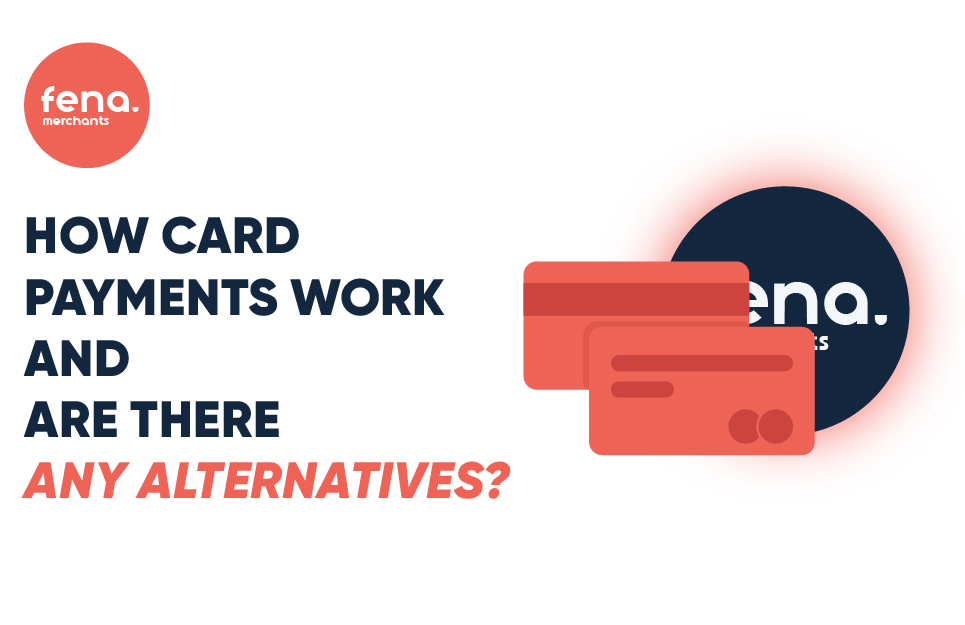How do card payments work, and what are the alternatives?
by Gosia Furmanik on November 17, 2021

Have you ever stopped to think about how card payments work and where the money goes? When a customer taps their card on a card machine or inputs their card number at an online checkout, this information is transferred through a chain of different players to approve (or reject) the transaction, and all within a matter of seconds . The first step to understanding this process of paying with ‘plastic money’ is to understand who those key player are:
Card holder:
The customer who uses a card to pay for their purchases.Merchant:
The business providing goods or services in exchange for payment.Acquirer or payment processor:
Processes payments for the merchant, and supplies the merchant with a ‘merchant account’.Issuer (or issuing bank):
The institution responsible for issuing credit cards.Payment scheme or card network:
The payment network linked to the card – they provide a link between the acquirer and the issuer. The biggest payment networks are Visa and MasterCard.Payment gateway:
Software that enables a card holder’s card details to be transferred from the merchant to the payment processor.
Now that you have an overview of the payment ecosystem, it’s time to check out how the purchase process itself works!
The card holder decides to pay by card, this could be online or in store
The transaction details are transferred to the payment gateway
The payment gateway in turn transfers the details to the acquirer/payment processor
The acquirer/payment processor transfers the info to the relevant payment scheme
The payment scheme finally passes this information onto the issuer to establish if the card holder can make the payment
The issuer runs a number of checks, such as checking the account balance or if there is a limit on transaction size
The issuer then returns their response, essentially the reverse of the previous actions – first notifying the card network, who tells the payment processor, who relays the message to the payment gateway, who then lets the merchant and customer know
This final message could be authorisation of the payment, in which case every party along the way takes a fee for their service, or it could be a rejection if the checks have not passed
Once complete, and if the payment is approved, there is then another process which settles the accounts and ensures the merchant receives their money, minus all the fees charged. To keep it simple:
The merchant would tell the acquirer all the authorised transactions for that day
This info is then sent to the payment scheme, who takes money from (debits) the card holder’s bank, and gives money to (credits) the merchant’s bank account
The issuer finally updates the card holder’s bank account
In total, this process can take a few days
With the emergence of new technologies and updated regulatory frameworks, the payments landscape is changing rapidly. As such, it’s crucial for merchants to understand the impact of alternative payment methods on their bottom line, especially when it comes to cost and convenience.
Offering modern means of payment to customers, whether in-store or online, is important to consumers and merchants. Just some of the reasons include the fact that modern payment systems:
are much faster
offer bank level security and can reduce fraud
provide impressive management software that helps merchants manage all their transactions from the comfort of their own home or office
can lower operational costs
save time, at no additional cost
provide a better experience, keeping your customers satisfied and coming back
Whilst, and let’s be honest, Visa and MasterCard aren’t going anywhere, it’s vital for businesses to be mindful of Open Banking, its significant advantages and how payments tech is shifting.
Open Banking is one strategy driving a revolution in banking. It places the user at the center, providing them control over their data. But what are the benefits to merchants?
Payments are streamlined
– rather than involving all the parties included in a card transaction, an instant bank transfer can be made between the customer and the merchant bank accounts.It’s cheaper
– by removing the large number of fee-charging parties, each transaction is considerably cheaper (up to 85%!).Reduced fraud
– by removing the need for card details, card not present fraud is reduced. The customer instead authenticates the transaction using their banking app, which typically requires face ID or a fingerprint to access.It’s quick
– rather than waiting days for payments to be settled, merchants can receive money in their account within minutes.It’s easy
– the customer doesn’t need their card to hand or to type in all their card details, if they have their bank app on their mobile they can authorise the payment with just a couple of taps.
Given the considerable benefits over traditional card payments, it’s no surprise that an increasing number of merchants are opting to offer Open Banking payments as part of their checkouts. And this is just the start, in the coming years expect to see a continuous stream of new payment innovations that will provide further benefits to both consumers and merchants, and a potential shift away from traditional card payments.